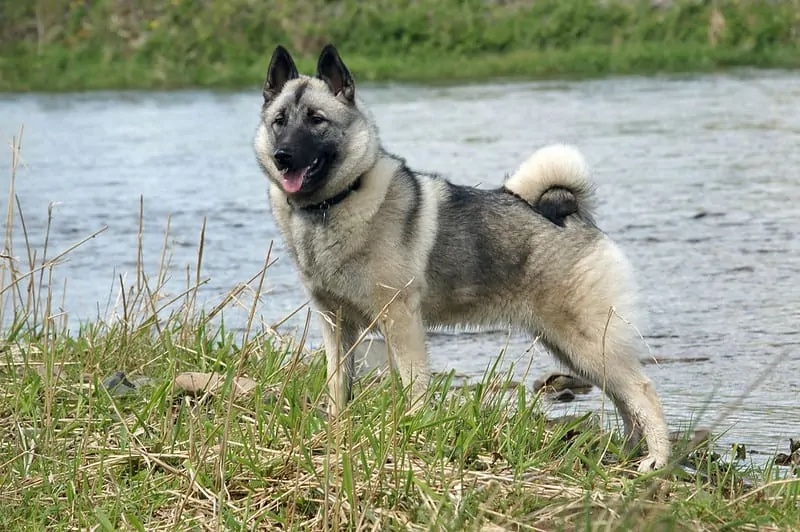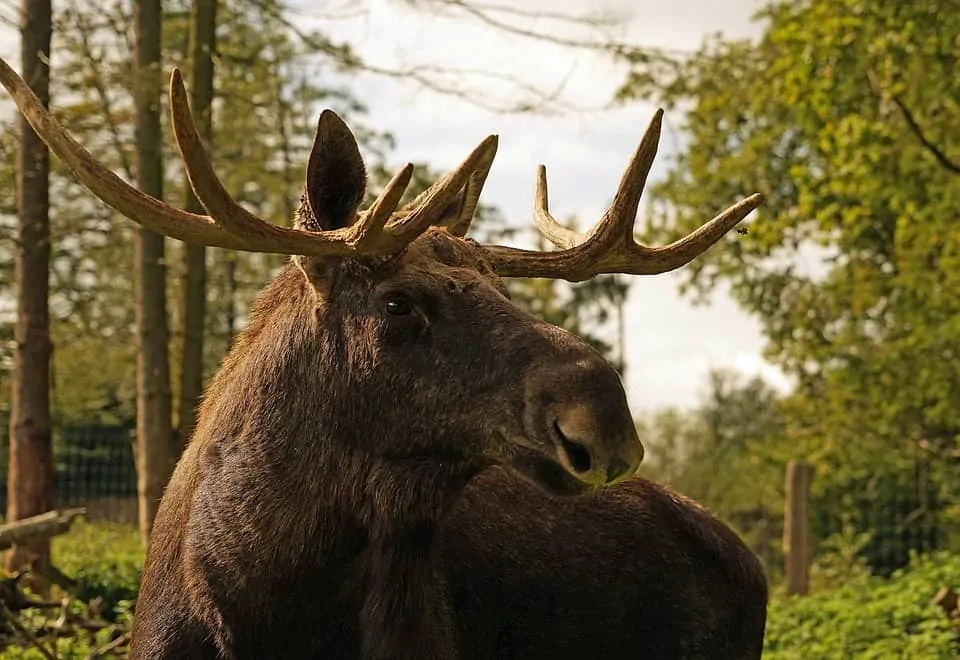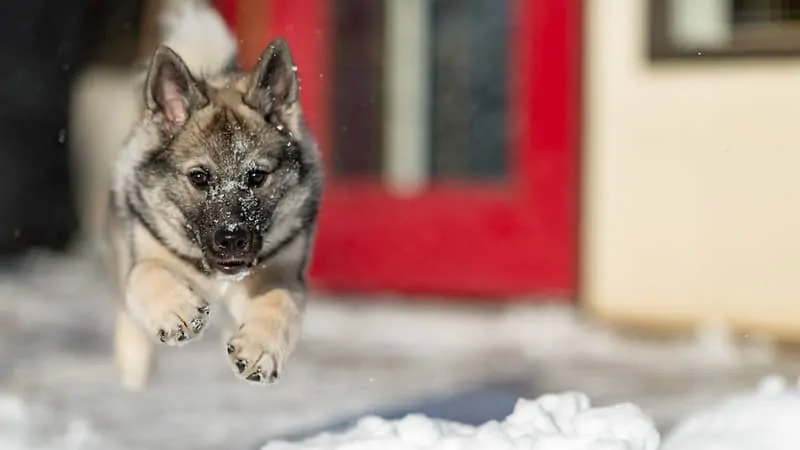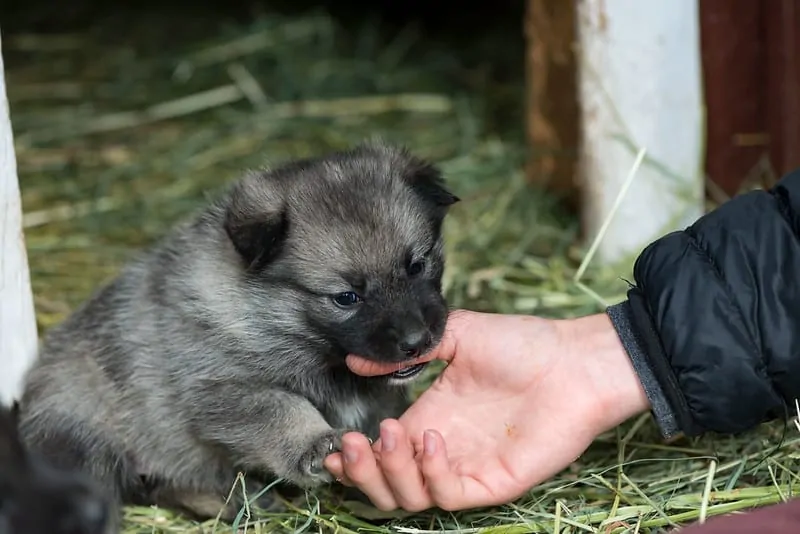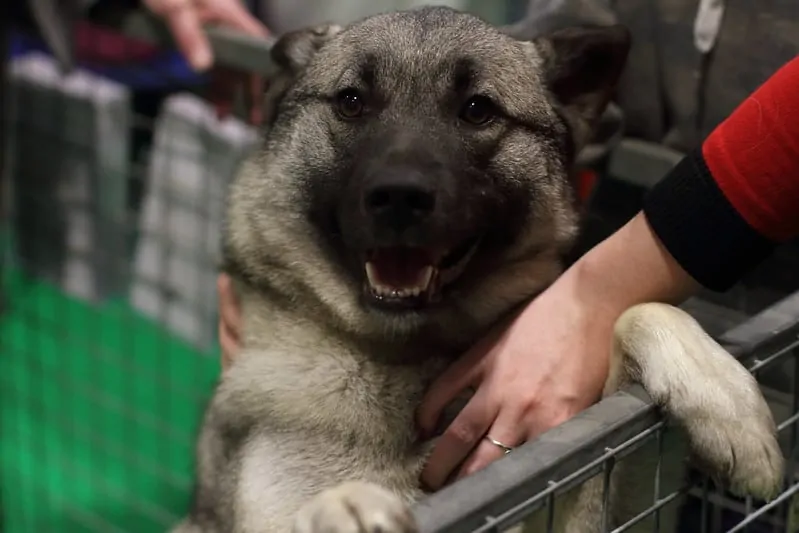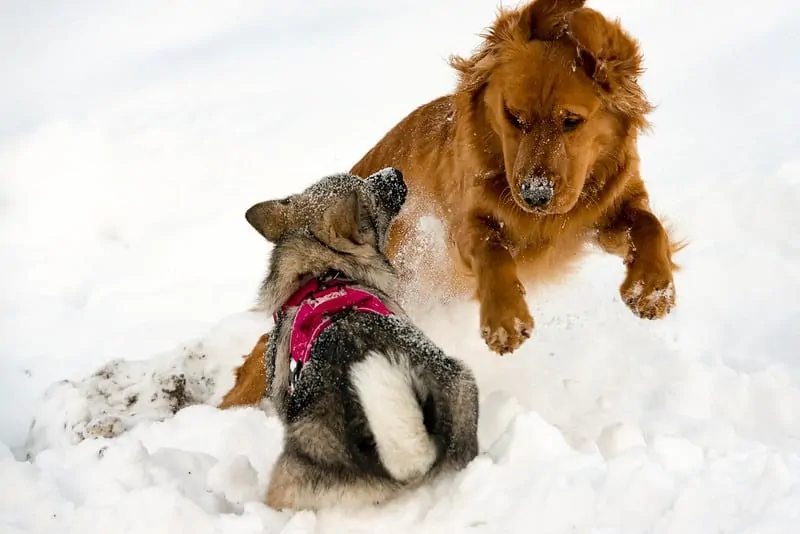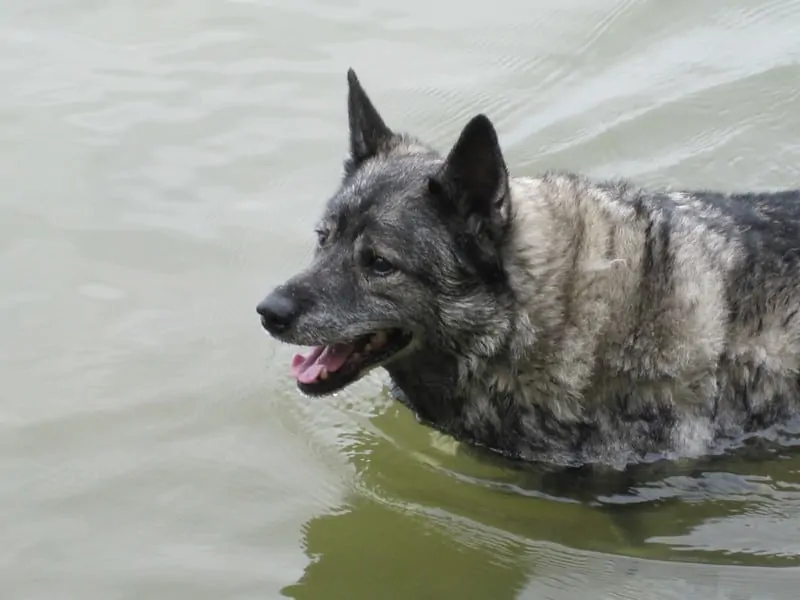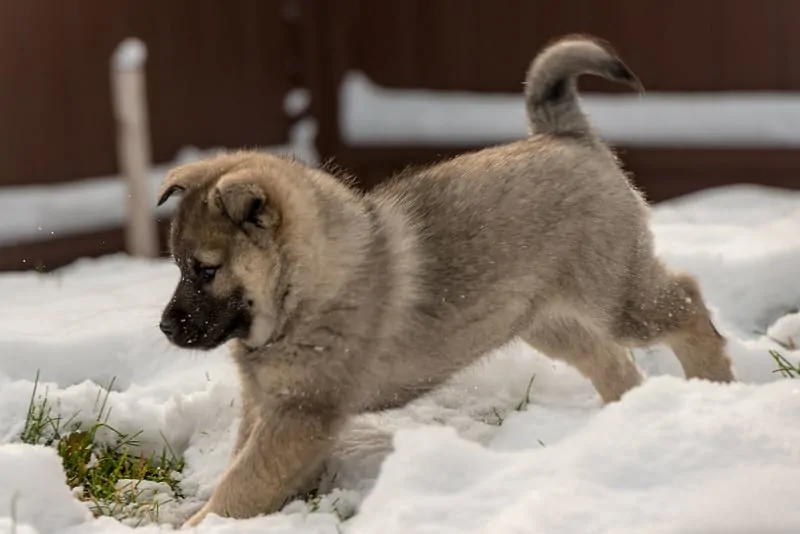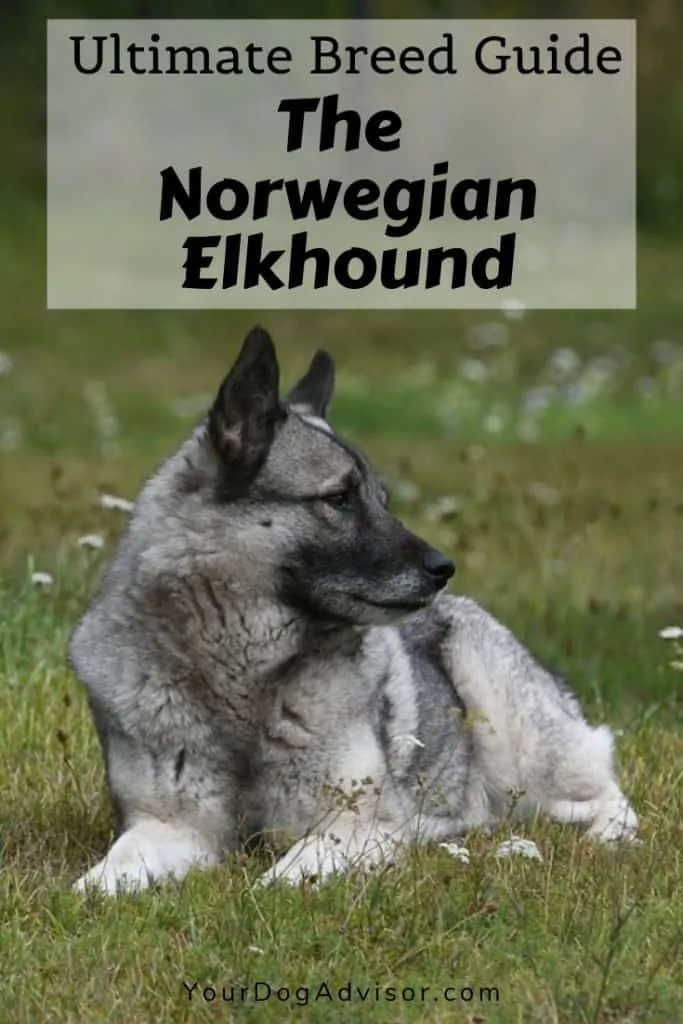Stout and mighty, there are few dogs with as much grit, intelligence, and confidence as this ancient Scandanavian breed. Despite their long history as a hunting and all-around utility dog, the Elkhound is most famous today for its role as a loyal and cuddly companion.
But these feisty characters aren’t right for just anyone. Keep reading to find out if you have the right personality and lifestyle to tame the prized breed of the Vikings.
Contents
General Characteristics of the Norwegian Elkhound
- Other names: Norsk Elghund
- Height: 20 inches
- Weight: 48 to 55 pounds
- Lifespan: 12 to 14 years
- Origin: Norway
- Colors: Grey sable with a black mask
- Activity level: High
- Grooming needs: Medium-high
- Best suited for: Active, outdoorsy owners
The Norwegian hound was built to withstand the unforgiving climate and rugged terrain of the Scandinavian countryside. Because of that, these dogs are capable climbers and swimmers. “Norwegian_Elkhound_1” by atomtetsuwan2002 / CC BY-SA 2.0
The History of the Norwegian Elkhound
The Norwegian Elkhound can trace its lineage back to a time before the Vikings ruled Scandanavia.
In fact, a cave in western Norway housing the remains of a neolithic tribe–some of the earliest known humans in Norway–was found to contain two canine skeletons from Elkhound-like dogs. The bones are believed to be about 7,000 years old.
These peoples settled in the area about 8,000 years ago and sustained themselves on a diet that consisted of gathered plant matter and meat from boar, moose, and seal.
While it would be impossible to say whether the Elkhound-type dogs that lived with the tribe were used to hunt these large animals, we do know that during the time of the Vikings starting around 800 AD, the Norwegian Elkhound was prized for its ability to aid in the hunt.
The role of the earliest Norwegian hounds during hunts is very similar to what many in Scandanavia are still used for today. These agile dogs, with their keen sense of smell, would track moose, bear, and boar through the rugged terrain. Once the animal was in sight, they would begin barking and lunging at it, signaling their position to their masters and holding the animal at bay until their people could kill it.
The name “Elkhound” can breed some confusion since the Eurasian elk for which the breed is named and the American elk are actually two very different species. The Eurasian elk, pictured above, is actually a close relative of the American moose.
But hunting was not the only job these dogs held during their early days with humans. They were also capable herding dogs and livestock guardians, as well as protectors of the home. They were even utilized as pack and hauling animals when needed.
At some point in their lineage, a female wolf bred with a male Elkhound-type dog. This wolf mitochondrial DNA can still be found in all Elkies today. In fact, all native Scandanavian breeds, including the Finnish and Swedish Lapphunds and the Lapponian Herder, have this DNA in their genes.
Despite being around for millennia, the Elky did not become widely known across Europe until the 19th century. The curly-tailed northern hound appeared in some of the first dog shows and was officially recognized as a breed by the Kennel Club in 1901.
The dog’s popularity in America followed soon after and they were officially listed as a breed with the AKC in 1913.
Today, many Elkhounds, especially those living in Scandanavia, are still used as hunting hounds. But the vast majority of today’s Elkies are kept as companion dogs and revered by owners for their loving, yet independent personalities.
<iframe width=”560″ height=”315″ src=”https://www.youtube.com/embed/sKdTVlLFnNc” frameborder=”0″ allow=”accelerometer; autoplay; encrypted-media; gyroscope; picture-in-picture” allowfullscreen></iframe>
Watch a Norwegian hound at work against a 1500 pound moose, in the above video. Notice how the dog works to bring the animal toward the waiting hunters.
The Temperament of the Norwegian Elkhound
No matter which task they were completing back in ancient times, the Elky relied on a keen intelligence, an independent work ethic, and an undying loyalty to their people to get it done. Many of these traits are still visible in the breed today.
Like their cousins to the south, this hound enjoys their freedom and is capable of thinking through problems and entertaining themselves. But they are not a dog who enjoys being left alone. They like to be in on the action. And when they have finally tired themselves out, they are happy to curl up next to you on the couch and enjoy a good snuggle.
The Elky’s loyalty is not just reserved for their families, though it usually takes a little time for them to warm up to strangers. But once someone is considered a friend, they keep the title for life. Despite their warm nature, they do make good watchdogs and their especially shrill bark is perfect for warning their owners of an intruder.
While an Elky may attack if they feel their people are in danger, these dogs are not typically quick to aggress. They tend to be very tolerant and enjoy rough play and a good game of chase.
The Norwegian hound is energetic and happy, whether young or old, and require a lot of attention and exercise. They especially love the snow and dashing across the open forest. “Pepper 17 Weeks 1-4” by Harold.Shock / CC BY-SA 2.0
Despite being of higher than average intelligence, these dogs are not always the best listeners. They enjoy learning new behaviors but are likely to get bored with any single task very quickly.
This need for constant excitement also means these dogs require a fair amount of activity. A 30-minute jog or a long hike is their preferred way to exercise, but a decent walk along a novel path will also help feed their mind while tiring them out.
Overall, the Elky is an active breed with a fun-loving, excitement-seeking personality that can make the perfect dog for any owner who values an independent, but loving canine.
Health Issues Common to the Norwegian Elkhound Breed
Like many ancient breeds, the Norwegian Elkhound is generally very healthy. Many individuals in the breed have been documented living to the age of 18, and most stay active and healthy well into their senior years.
However, there are some health conditions that can pop up from time to time. Here are the more common health issues seen in the Norwegian Elkhound.
- Eye problems/blindness
- Heart conditions
- Renal problems
- Hip dysplasia
- Cancer
- Dermal cysts
Choosing a reputable breeder will help assure the Norwegian you get lives up to the breed’s healthy reputation. Lines that have experienced irresponsible outbreeding or inbreeding tend to carry more genetic issues than well-bred dogs. “Puppy-1-7” by Harold.Shock / CC BY-SA 2.0
For many owners, the trick to maintaining a healthy Elkhound has less to do with finding the perfect breeder and more to do with keeping their dog fit and trim.
Elkies tend to be food-hounds in every sense of the word. Unlike some northern breeds, they do not approach their bowls like cats, but more like your typical Labrador. This trait makes them especially prone to weight gain and obesity. Combine this with a stout build and a very fluffy coat, and you have a recipe for a puffy pup.
The first step to keeping your Elky at a healthy weight and avoiding all the nasty health problems, such as joint issues, heart problems, and certain cancers, that come with it, is to be able to accurately identify if your Norwegian hound is at a proper weight.
>>>Here are our picks for the best diet dog foods.
Because these dogs have compact bodies and thick coats, this can be hard to tell just by looking at them. One trick is to watch your Elky when they are eating or drinking. As they swallow, their abdomen, just behind their ribcage, will sink in. If you can see a noticeable dip during this process, they are likely not overweight.
You can also try running your fingers into their coat and over their ribs. You should be able to feel their ribs toward their back end.
The coat of an overweight Elky also tends to roll when they move. If your Elkhound’s skin moves like waves across the ocean when they trot, know that this is not a characteristic of their puffy coat. It is actually an extra layer of fat that needs to be exercised away.
The deep brown, soulful eyes of the Norwegian are well-known for their ability to convey emotion. And they are one of the reasons these dogs are so often allowed to overindulge in treats and table scraps. Who could say no to that face? “Crufts 2019: NEC, Birmingham: 08-March 2019” by Adam W / CC BY 2.0
Do Norwegian Elkhounds Do Well With Children and Other Pets?
Elkhounds are typically good with children, preferring to observe smaller babies and toddlers and romp around with older kids. Their tolerant and loyal nature makes them a good choice for families.
Because they do have some herding instinct, precaution should be taken when young children are running around the house or yard. An overly excited Norwegian Elkhound may try to join in the game by nipping at a heel or barking aggressively.
Of course, all dogs are individuals and how well your new hound does with your kids will depend on their unique personality and how well they were socialized with little ones as a puppy.
When it comes to other dogs, Elkies tend to be fairly sociable. Most enjoy playing with dogs of similar size while others are happy just to chase and bark while others play. At the dog park and in large playgroups, it is not uncommon for an Elky to hone in on a larger dog and try to corner it similar to the way their ancestors cornered moose and caribou.
Early socialization is key to building an adult Norwegian who gets along well with other dogs and animals. These pups can have a dominant and feisty personality that can easily become overbearing without proper work in puppyhood. “Pepper4Months-5” by Harold.Shock / CC BY-SA 2.0
While most Norwegian hounds enjoy the chase, they don’t typically have an intense prey drive and can do well with other furry family members. If you plan to have your Elky cohabitate with cats and other furry creatures, it is best to introduce them to these pets when they are puppies.
What to Consider Before Bringing Home a Norwegian Elkhound
Think one of these ancient Viking dogs would make the perfect companion for you? Here are a few more considerations before bringing your own fluffy Thor home.
Activity Level
These dogs need plenty of mental and physical activity to avoid problem behaviors like chewing and barking. Daily walks, jogs, or hikes are a great start. They are also great candidates for a long list of dog sports, including tracking, scent work, agility, herding, and skijoring.
Not only are under-exercised Elkies more likely to engage in unwanted behaviors, but they are also likely to become overweight. No matter how much time your dog spends running around or pulling you on your skis, it is important to portion their meals appropriately.
Trainability
These intelligent dogs pick up new behaviors very quickly, but they may not always do what you ask. When you are practicing your obedience, it is best to keep lessons short and move between different behaviors to keep your pup engaged. Despite their tendency toward distraction and boredom, these hounds do tend to like their food, so treats are a great motivator.
You may not think it by looking at them, but the Norwegian enjoys a good dip in the lake. Swimming is a great activity for old and young Elkies alike. “Darby” by Suzanne Graham / CC BY-ND 2.0
Grooming
The Norwegian Elkhound has a thick, fluffy undercoat and a coarse, thicker outer coat that protects it. Both of these fur types combine to make one big mess on your floor, especially during their seasonal shed. A decent brushing once a day is necessary to keep them and your floors looking their best. Use a “back brushing” technique or brush against the hair to remove the loose fur.
>>>Here are our picks for the best dog brushes.
Luckily, these dogs tend to stay clean and don’t have the typically doggy odor, so a few baths a year are usually all they require.
Nutrition
Your Elky will do well on any high-quality commercial or raw dog food so long as they are not allowed to overindulge. While measuring out meals is a must, don’t overlook treats and table scraps as something that also contributes to weight gain. Most Elkies will happily accept kibble for a reward during training. By deducting these calories straight from their next meal you can avoid overfeeding.
Cost
A purebred Elkhound puppy will typically cost as much as your standard pup at around $500 to $700. Though, it is possible to find show quality dogs that go for as high as $5,000.
Overall, the Elky is a healthy, happy pup that won’t likely cost you a ton in vet bills but may require some extra budgeting for activities.
10 Fun Facts About the Norwegian Elkhound
Now that you know what it takes to own an Elkhound, here are some fun facts about the breed.
- Ancient Elkhounds often set sail with their Viking owners and were very comfortable at sea.
- They really enjoy swimming, an important characteristic in a dog that is used to hunt water-loving moose.
The Norwegian’s gray sable coloring may be a call back to their earliest proto-dog relatives, who likely had coats that resembled wild wolves. “Day1-7” by Harold.Shock / CC BY-SA 2.0
- The breed’s name is misleading. The Eurasian elk, which is what the breed was primarily used to hunt, is most closely related in size and genes to the American moose not the American elk.
- It is said that the Norse once named an Elky king of the land of Thorndhejm.
- When on the trail of game or on leash, the Elky is a silent hunter. Only once the prey is in sight will they engage in frequent, loud, barks to distract the animal while their owner sneaks up on it.
- The most skilled Elies will drive moose and other game toward their owner during the hunt.
- These dogs may be one of the bravest in the canine kingdom, capable of holding and dodging animals forty times their weight.
- While they may not look like your typical hound, these trackers can keep up with the best of them and do it in the harsh, freezing terrain of the near-arctic circle.
- The breed has been around for about 7,000 years.
- They are likely one of the closest living breeds to the original proto-dogs that were first domesticated by humans.
Before You Go
Not sure the independent and active Elky is for you? Here are a few more breeds to consider.

Sara Seitz has spent most of her life in the pet industry and has a bachelors in animal behavior from Colorado State University. Sara started working with dogs and cats as a high schooler at a rural boarding kennel. There she learned a lot about the bad and the ugly of the pet service industry. But not even the toughest day at that job would dissuade Sara from following her dream of working with animals.
In college, Sara got a job at a dog daycare and boarding facility in Fort Collins, Colorado. Her new career provided even more opportunities for learning about dog behavior than her classes did. As general manager of the daycare, Sara helped the company launch a new in-home pet sitting branch and trained to become a certified dog trainer. Between shifts taking care of peoples pets in-home and supervising dogs during playtime at the daycare, Sara organized and taught obedience classes.
Sara has always been passionate about bettering the lives of our canine companions. She soon found that advocating for and educating owners in the power of positive reinforcement training was one of the best ways to help dogs and their owners live happier lives.
